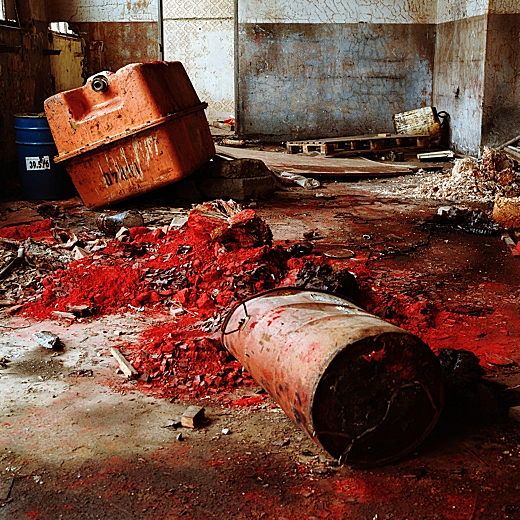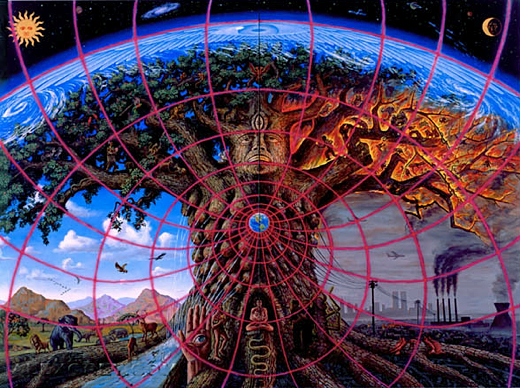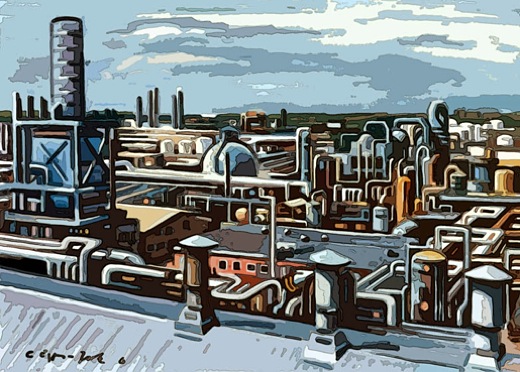SUBHEAD: The soon-to-be-deindustrializing world will be in need of 'green wizards' with the skills of the old appropriate tech movement.
By John Michael Greer on 30 June 2010 in The Archdruid Report -
(http://thearchdruidreport.blogspot.com/2010/06/merlins-time.html)
 Image above: Still frame of Ian McClellan as Gandalf in Lord of the Rings. From (http://blog.newsok.com/bamsblog/2008/04/30/back-to-middle-earth-for-lotr-cast/).
Image above: Still frame of Ian McClellan as Gandalf in Lord of the Rings. From (http://blog.newsok.com/bamsblog/2008/04/30/back-to-middle-earth-for-lotr-cast/).
Perhaps the most interesting responses to the discussion of mass movements here on
The Archdruid Report have been those that insisted that the only alternative, either to a mass movement in the abstract or to some specific movement, was defeat and despair.
That’s an odd sort of logic, since mass movements are hardly the only tool in the drawer; I suspect that part of what drives the insistence is the herd-mindedness of our species – we are, after all, social mammals with most of the same inborn habits of collective behavior you’ll find in any of the less solitary vertebrates.
Still, the pressure toward some such movement has another potent force driving it: the awkward fact that the vast majority of people today simply do not want to hear how difficult their future is going to be. It doesn’t matter how good your evidence is or how well you make your case, most of your listeners will simply look uncomfortable and change the subject.
Why this should be the case is an interesting question; I suspect that much of the blame lies with the cult of positive thinking Barbara Ehrenreich anatomized in
a recent book, though I’m quite willing to hear alternative explanations.
Still, for whatever reason, an extraordinary blindness to the downside has become crazy-glued in place straight across contemporary culture. From economists who insist that the bubble du jour (right now, in case you haven’t noticed, it’s government debt) can keep on inflating forever, through technology fans who believe devoutly that their favorite piece of drawing-board vaporware will necessarily solve the world’s problems without side effects and with spare change left over, to millions of ordinary people who can’t or won’t imagine a future without the material abundance of recent decades, we seem to have lost the collective capacity to recognize that things can and do go very, very wrong.
It’s not merely a matter of blindness to the “black swan” events Nassim Nicholas Taleb made famous, either; we’re just as bad at seeing white swans coming, even when they’ve been predicted for decades and the sky is so thick with them that it’s hard to see anything else.
It’s an appalling predicament: how can a community prepare for a troubled future if most people tune out even the slightest suggestion that it might be troubled? It’s for this reason, seemingly, that many people in the Peak Oil scene have chosen to downplay the difficulties and insist that we can have a bright, happy, abundant future if we just pursue whatever baby steps toward sustainability we all find congenial.
I’ve been assured by some of the people making such claims that they’re perfectly aware that the situation is far more difficult and dangerous than that, but that the need to get as people involved in some kind of movement toward sustainability is so great, they say, that waffling on that point is as justified as it is necessary.
As it happens, I think they’re making a hideous mistake. I’ve discussed the reasons for that perception at length in several recent posts, and won’t rehash them here.
The question that remains is whether there are any viable alternatives, and that’s the question I want to address in today’s post. To explain the option I have in mind, though, it may be useful to borrow a metaphor from history.
I don’t know how many of my readers know this, but my most recent publication is a translation of a
very strange book from the Middle Ages. Its title is
Picatrix, and it is one of the sole surviving examples of that absolute rarity of medieval literature, a textbook for apprentice wizards.
Those of my readers who grew up on stories about Merlin, Gandalf et al. take note: Those characters, legendary or fictional as they are, were modeled on an actual profession that flourished in the early Middle Ages, and remained relatively active until the bottom fell out of the market at the end of the Renaissance.
By "wizard" here I don’t mean your common or garden variety fortune teller or ritual practitioner; we have those in abundance today. The wizard of the early Middle Ages in Europe and the Muslim world, rather, was a freelance intellectual whose main stock in trade was good advice, though admittedly that came well frosted with incantation and prophecy as needed. He had a good working knowledge of astrology, which filled roughly the same role in medieval thought that theoretical physics does today, and an equally solid knowledge of ritual magic, but his training did not begin or end there.
According to
Picatrix, the compleat wizard in training needed to get a thorough education in agriculture; navigation; political science; military science; grammar, languages, and rhetoric; commerce, all the mathematics known at the time, including arithmetic, geometry, music theory, and astronomy; logic; medicine, including a good knowledge of herbal pharmaceuticals; the natural sciences, including meteorology, mineralogy, botany, and zoology; and Aristotle’s metaphysics: in effect, the sum total of the scientific learning that had survived from the classical world.
Now it may have occurred to my readers that this doesn’t sound like the sort of education you’d get at Hogwarts, and that’s exactly the point. Whether you believe that the movements of the planets foretell events on Earth, as almost everyone did in the Middle Ages, or whether you think astrology is simply a clever anticipation of game theory that gets its results by inserting random factors into strategic decisions to make them unpredictable, you’ll likely recognize that a soothsayer with the sort of background I’ve just sketched out would be well prepared to offer sound advice on most of the questions that might perplex a medieval peasant, merchant, baron or king.
Nor, of course, would someone so trained be restricted in his choice of active measures to incantations alone.
This is arguably why so many medieval kings and barons had professional sorcerers and soothsayers on staff, despite the fulminations of all the dominant religions of the age, and why wizards less adept at social climbing found a bumper crop of customers lower down the social ladder.
The origins of this profession are, if anything, even more interesting.
Pierre Riché’s useful study
Education and Culture in the Barbarian West showed in detail how the educational institutions of the late Roman world imploded as their economic and social support systems crumpled beneath them. In Europe – matters were a little more complex in the Muslim world – they were replaced by a monastic system of education that, in its early days, fixated almost entirely on scriptural and theological studies, and by methods of training young aristocrats that fixated even more tightly on the skills of warfare and government.
Only among families with a tradition of classical letters did some semblance of the old curriculum stay in use, and Riché notes that while that custom continued, those who learned philosophy, one of the core studies in that curriculum, were widely suspected of dabbling in magic. It’s not too hard to connect the dots and see how a subculture of freelance intellectuals, equipped with unusual knowledge and a willingness to stray well outside the boundaries set by the culture of their time, would have emerged from that context.
All this may seem worlds away from the issues raised earlier in this essay, but there’s a direct connection.
The wizards of the early Middle Ages were individuals who recognized the value of certain branches of knowledge and certain attitudes toward the world that were profoundly unpopular in their time, and took it on themselves to preserve the knowledge, cultivate the attitudes, and make connections with those who shared the same sense of values, or at least were interested in making practical use of the skills that the knowledge and attitudes made possible.
There was no mass movement to support the survival of classical science in the sixth and seventh centuries CE, and no hope of starting one; the mass movements of the time – when they weren’t simply stampeding mobs trying to get out of the way of the latest round of barbarian invasions – embraced the opposite opinion.
How much of a role wizards might have played in the transmission of classical learning to the future is anyone’s guess, since records of their activities are very sparse, but it’s clear that they were an intellectual resource much used during an age when few other resources of the kind were available.
I’ve come to think that a strategy of the same kind, if a bit more tightly focused, might well be one of the best options just now for an age when very few people are willing to make meaningful preparations for a difficult future.
Certain branches of practical knowledge, thoroughly learned and just as thoroughly practiced by a relatively modest number of people, could be deployed in a hurry to help mitigate the impact of the energy shortages, economic dislocations, and systems breakdowns that are tolerably certain to punctuate the years ahead of us.
I’m sure my readers have their own ideas about the kind of knowledge that might be best suited to that context, but I have a particular suggestion to offer: The legacy of the appropriate technology movement of the 1970s.
This was not simply a precursor of today’s sustainability projects, and the differences are important. The appropriate tech movement, with some exceptions, tended to avoid the kind of high-cost, high-profile eco-chic projects so common today.
Much of it focused instead on simple technologies that could be put to work by ordinary people without six-figure incomes, doing the work themselves, using ordinary tools and readily available resources.
Most of these technologies were evolved by basement-shop craftspeople and small nonprofits working on shoestring budgets, and ruthlessly field-tested by thousands of people who built their own versions in their backyards and wrote about the results in the letters column of
Mother Earth News.
The resulting toolkit was a remarkably well integrated, effective, and cost-effective set of approaches that individuals, families, and communities could use to sharply reduce their dependence on fossil fuels and the industrial system in general.
It was not, I should probably point out, particularly aesthetic, unless you happen to like a lively fusion of down home funk, late twentieth century garage-workshop, and hand-dyed back-to-the-land hippie paisley; those of my readers who own houses and are still fretting about their resale value (and haven’t yet figured out that this figure will be denominated in imaginary numbers for the next several decades at least) will likely run screaming from it; those who were incautious enough to buy homes in suburban developments with restrictive covenants will have to step carefully, at least until their neighbors panic.
Apartment dwellers will have to pick and choose a bit; on the other hand, those of my readers who will spend time living in tarpaper shacks before the Great Recession ends – and I suspect a fair number of people will have that experience, as a fair number of people did the last time the economy lost touch with reality and imploded the way it’s currently doing – will find that very nearly everything the appropriate tech people did will be well within their reach.
What’s included in the package I’m discussing? Intensive organic gardening, for starters, with its support technologies of composting, green manure, season extenders, and low-tech food preservation and storage methods; small-scale chicken and rabbit raising, and home aquaculture of fish; simple attached solar greenhouses, which make the transition from food to energy by providing heat for homes as well as food for the table; other retrofitted passive solar heating technologies; solar water heating; a baker’s dozen or more methods for conserving hot or cool air with little or no energy input; and a good deal more.
None of it will save the world, if that hackneyed phrase means maintaining business as usual on some supposedly sustainable basis; what it can do is make human life in a world suffering from serious energy shortages and economic troubles a good deal less traumatic and more livable.
This is the suite of technologies I studied as a budding appropriate-tech geek during the late 1970s and 1980s, and it was central to the training program that earned me my Master Conserver certificate in 1985. One teaches what one knows, and I’m going to take the gamble of devoting much of the next year or so of
Archdruid Report posts to the details.
My hope is that I can encourage at least a few of my readers to follow the very old example mentioned earlier, and become the green wizards of the decades ahead of us.
For that, I have come to think, is one of the things the soon-to-be-deindustrializing world most needs just now: green wizards.
By this I mean individuals who are willing to take on the responsibility to learn, practice, and thoroughly master a set of unpopular but valuable skills – the skills of the old appropriate tech movement – and share them with their neighbors when the day comes that their neighbors are willing to learn.
This is not a subject where armchair theorizing counts for much – as every wizard’s apprentice learns sooner rather than later, what you really know is measured by what you’ve actually done – and it’s probably not going to earn anyone a living any time soon, either, though it can help almost anyone make whatever living they earn go a great deal further than it might otherwise go.
Nor, again, will it prevent the unraveling of the industrial age and the coming of a harsh new world; what it can do, if enough people seize the opportunity, is make the rough road to that new world more bearable than it will otherwise be.
I also propose to have a certain amount of fun with the wizard archetype in the posts to come.
Still, that’s an example of what the Renaissance alchemist Michael Maier called a
lusus serius, a game played in earnest, a dead serious joke. The present time, as I’ve suggested here more than once, has plenty of features in common with the twilight years of classical civilization, the age that gave rise to the legends of Merlin and Arthur, and made it in retrospect a poetic necessity for the greatest of all legendary kings to be advised by the greatest of all legendary wizards.
Thus there’s a certain lively irony in the fact that, back in the days when I was sanding blades for a homebuilt wind turbine and studying the laws of thermodynamics in Master Conserver classes in the meeting room of the old Seattle Public library, one of my favorite bits of music was Al Stewart’s
Merlin’s Time:
Who would walk the stony roads of Merlin’s time,
And keep the watch along the borderline?
And who would hear the legends passed in song and rhyme
Upon the shepherd pipes of Merlin’s time?
In its own way, that’s the question that upcoming posts will pose to my readers; we’ll see what the answer turns out to be
.
.







